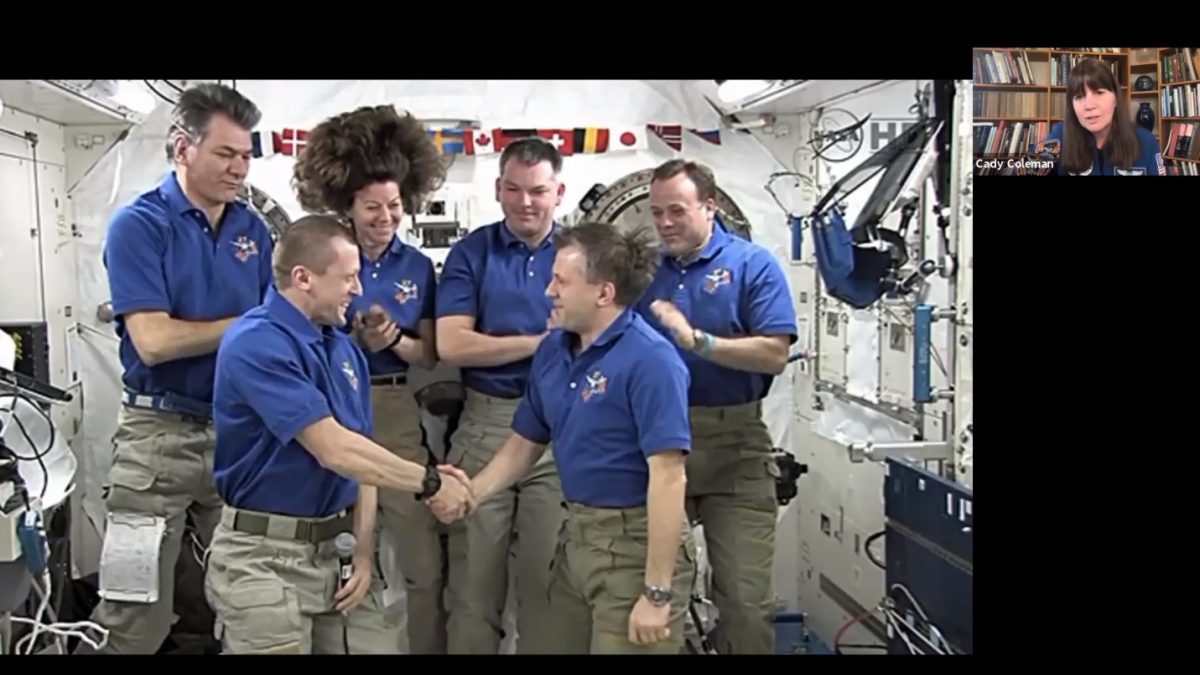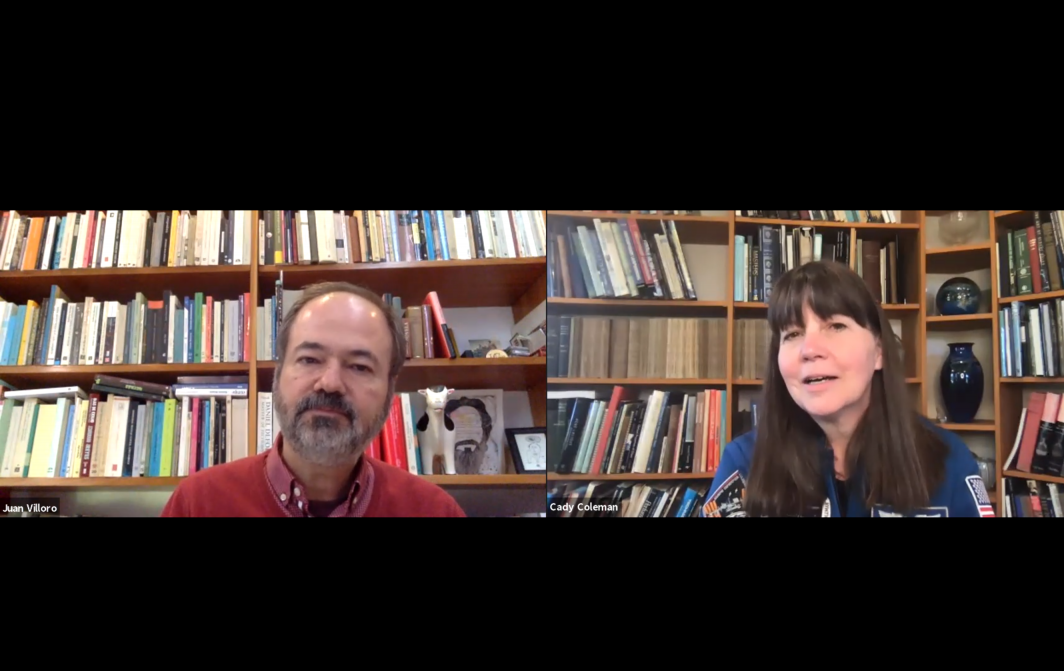When you’re an astronaut, whom do you represent? Do you represent the citizens of the country whose flag is emblazoned on your suit? Or do you represent a larger group of people, all those billions of humans whose lives light up the planet below you?
That was Juan Villoro’s first question for Cady Coleman, ASU’s Global Explorer in Residence and a former NASA astronaut, in Wednesday’s virtual Convergence Lab event. ASU’s Convergence Lab, a series of events usually held in person in Mexico City, brings together communities across borders to learn from each other — with the ultimate goal of building a better, shared North American future.
Villoro, a renowned Mexican journalist, novelist and playwright, spoke with Coleman about her experiences in space, and together the two discussed ways to make the future of space exploration a more inclusive one.
“I have my U.S. patch on my sleeve,” Coleman said, pointing to the American flag on her uniform. “It's hard to say this without sounding like you don't appreciate your home, or the fact that we all come from somewhere. But looking back at the Earth, we're all from the same place … we’re all from there.”
Though Mexico doesn’t have a national space program equivalent to NASA (the Mexican Space Agency is focused principally on research and education and doesn’t send humans to space), the country has a long history of looking toward the stars, Villoro said — from Mayan astronomers to present-day visionaries like Alfonso Cuarón, director of the film “Gravity,” which Coleman consulted on.
Cady Coleman, ASU's Global Explorer in Residence and former NASA astronaut, and Juan Villoro, award-winning writer and journalist, discuss international collaboration and our shared future in space in a virtual Convergence Lab event June 17. Screenshot courtesy of Mia Armstrong
When Cuarón won an Oscar for “Gravity,” “many people thought, 'Well, how come a Mexican is so deeply interested in outer space and is so accurate in his redemption of what's going on out there?' ” Villoro said.
The answer, he said, is “because this adventure has been important for the whole human race.”
Villoro was 12 when Apollo 11 reached the moon, he remembered, “and for my generation that changed the whole idea of the universe.”
This shared idea of the universe is a constantly shifting one, Coleman said, especially as we push existing barriers and discover new limits to our knowledge of space, and also incorporate new perspectives into our exploration of it.
“What I discovered when I got to go to space was I used to think that we're here on Earth, and then space is somewhere else, and some people go,” she said. “But actually, Earth and the place that we call home is just bigger than we thought, and just not enough people have been to these edges yet.”
Through its School of Earth and Space Exploration and Interplanetary Initiative, ASU is trying to bring more people toward those edges. The ASU-led NASA Psyche Mission, set to launch in summer 2022, for example, offers free online classes that allow people from around the world to participate in the mission.
Villoro and Coleman discussed private-sector participation in space exploration: “I would go with whatever vehicle is leaving … I really love these additional collaborations,” Coleman said; human rights in space: “It’s a totally new turf,” Villoro said, which needs to be “solved by the whole community of the Earth”; and experiments on the International Space Station: “We’re learning things in space that really we can’t learn down here,” Coleman said.
One audience member, a psychology student from Mexico, asked Coleman for her advice to endure the social and physical isolation many of us have found ourselves in over the last several months. Coleman’s response? “Focus on the mission.”
READ MORE: Bringing astronaut skills down to Earth to handle isolation
Right now, there are many different important individual and societal missions, Coleman said. One is trying to keep ourselves, our families and our communities safe in the face of a global pandemic. Another is educating ourselves about our roles in systems that perpetuate racial inequality and injustice, and working to change that.
When asked by audience members whether they would jump on the opportunity to go to space again for an important mission, or accept a one-way ticket to Mars, Coleman and Villoro had different answers.
“Yes and yes,” Coleman said immediately.
“I will write about going to Mars, and I will write about somebody who has a single ticket to Mars, but I will never go there,” Villoro said, laughing.
The truth is, Villoro, the storyteller, and Coleman, the astronaut, both have equally important roles to fill. Art and storytelling, Coleman said, are crucial to building our future in space.
“When people see themselves in a story, in problem solving, then they think, ‘Oh, maybe this could be me,” she said.
So whether you’re writing a book or directing a commercial or illustrating a cartoon, Coleman urged, “Please, please, please include other people that really don't look or feel like you, because they're part of the equation. And by them seeing themselves in your story, it makes all the difference.”
In space, said Coleman, the thing that links everyone to each other, despite different government positions or priorities, is “the passion for exploration.” That passion is what spurred collaboration on the International Space Station, she remembered.
“It's always the people between each other that build those bridges,” Coleman said.
Those are bridges we can build from anywhere in the universe.
Watch the full event.
Written by Mia Armstrong.
Top image: Cady Coleman, ASU's Global Explorer in Residence and former NASA astronaut, shares a photo from the International Space Station and talks about the time she spent there during a binational Convergence Lab event June 17. Through two Space Shuttle missions and an almost six-month stint on the ISS, Coleman has logged a cumulative 180 days in space. Images courtesy of Cady Coleman and Mia Armstrong.
More Science and technology

Diagnosing data corruption
You are in your doctor’s office for your annual physical and you notice the change. This year, your doctor no longer has your health history in five-inch stack of paperwork fastened together with…
Large-scale study reveals true impact of ASU VR lab on science education
Students at Arizona State University love the Dreamscape Learn virtual reality biology experiences, and the intense engagement it creates is leading to higher grades and more persistence for biology…

ASU-led space telescope is ready to fly
The Star Planet Activity Research CubeSat, or SPARCS, a small space telescope that will monitor the flares and sunspot activity of low-mass stars, has now passed its pre-shipment review by NASA.…



